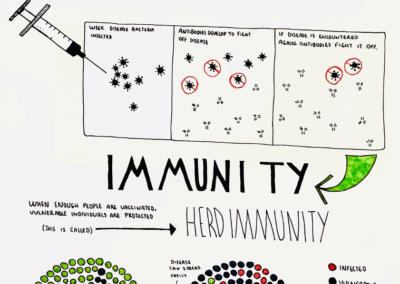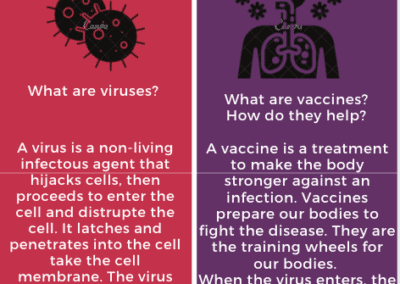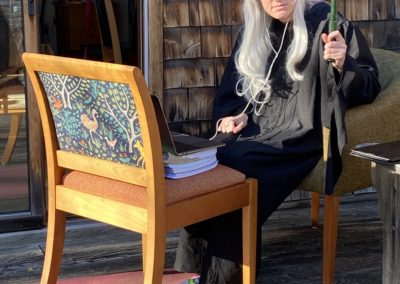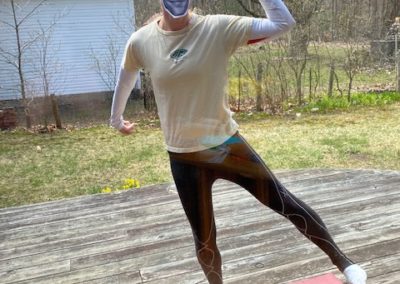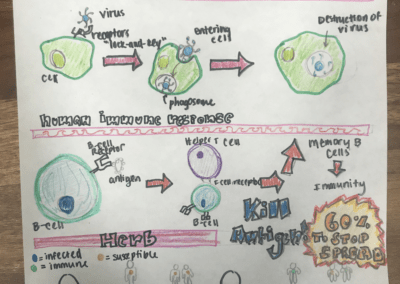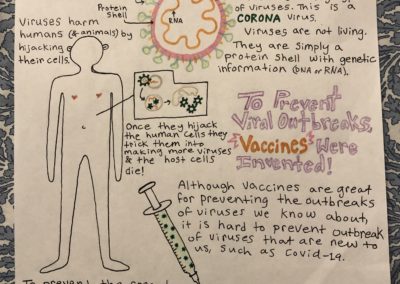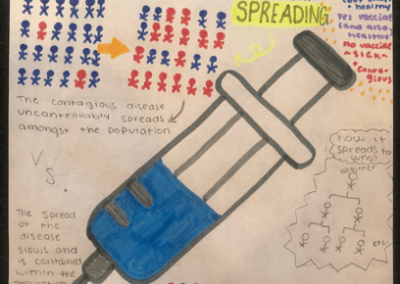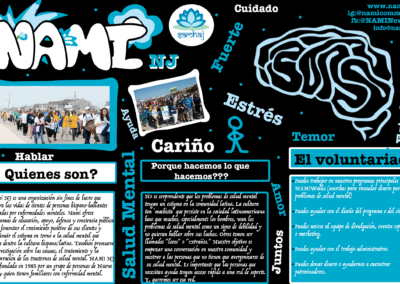While this semester unexpectedly switched from all experiential to virtual, our goal to make classes engaging and creative remains. Teachers have worked to bring costumes, videos, games and relevant material to class. Students have taken the lead and are researching local issues, tying these to larger global themes and preparing to be leaders. Check out what TTS35 has been up to in the past few weeks through these updates.
Honors Natural Science
In Honors Natural Science, students are prepared to educate the world about viral pandemics as demonstrated by their infographic project. Our infectious disease unit began in Peru as we pieced together scientific developments about the novel coronavirus to provide ourselves with context for understanding how our world was changing. We learned about the different types of human pathogens – bacteria, protozoa, viruses – and how they cause harm to human cells and systems. Next, we honed in on viral pathogenesis and unpacked the mechanism by which these simple organisms can wreak havoc within the human body by “hijacking” our cells. Our studies turned to focus on immunity, both on the individual level and also across populations. Finally, we examined the public health measures that are essential in an infectious disease crisis like contact tracing and widespread vaccination. Students were asked to distill their learning about infectious disease into an infographic. In their small posters, each titled “What You Need to Know in a Viral Pandemic” students arm the general public with the information essential to navigate these difficult times.
Check out a few infographics, and read some snips from students’ explanations:
From Jenna:
“Herd immunity occurs when so many people in a community become immune to an infectious disease that the spread of the disease slows down and eventually comes to a stop. When a new disease comes about it gets traced on whom it harms, and when and how it spreads it can be marked infectious. It is scaled using the Basic Reproduction Number, also referred to as R0, that is based upon the number of cases each infectious person gets and spreads to others. R0 uses an average of how many people that single contagious person can infect, and it ranges for each disease. For example, for every one person with Hepatitis C they transmit the disease to two others, on average, whereas for every one person with Measles transmits the disease to eighteen other people. As just stated, an infectious disease can be as contagious as an R0 of eighteen, so it is important that it be controlled. There are two ways to do this, through natural immunity and vaccine immunity. Natural immunity is when an individual’s body recovers after getting the disease, therefore gaining defenses against it. On the other hand vaccine immunity is where someone may become immune through getting a vaccine to combat the virus.”
From Zoe L:
“ The human body is made out of many cells, and of these cells, leukocytes(aka the white ones), play a super important role in the immune system! There are two types of leukocytes: phagocytes and lymphocytes. Phagocytes essentially kill invading organisms while lymphocytes aid the body in remembering and identifying these organisms. So, how does this all work? Well, when antigens enter the body, lymphocytes are immediately triggered to form antibodies, specialized proteins that lock onto antigens, and destroy it with the help of T-cells. T-cells, or killer cells, destroy antigens that are tagged by antibodies, and can also help signal phagocytes to do their job. Antibodies can also neutralize toxins(poisonous substances) and activate a collective of proteins called ‘complement’ which helps kill pathogens. “
From Ari:
“Vaccines work by injecting a small amount of dead or weakened (target) disease bacteria into an individual, who’s body then develops antibodies to fight it off. This is easier for the body to fight because it is a smaller, weaker, version of the disease. After the antibodies have developed and fought off the weak bacteria, the individual is considered immune. The next time they encounter the disease (in its full force), the antibodies that have been developed can fight it off.
When enough people get vaccinated, those who aren’t, are protected from the disease–this is called herd immunity. The disease is unable to pass through those who are immune, to get to vulnerable or unvaccinated individuals, they serve as a wall, stopping the spread. But when there are many unvaccinated individuals, the disease can easily spread through them and to those who might be more severely affected by it. Those who have conditions or allergies that prevent them from being able to get vaccinated, suffer the most from this. Getting vaccinated benefits the public health, not just the health of individuals.”
From Sadie:
Firstly, I explained what a virus actually is: a pathogen. I explained the spores and how the virus spreads within the human body to affect different areas of the human body. As seen in the infographic, once the virus enters the body it takes over a cell, damages the cell and uses it to produce more virus particles which then repeat the process. Depending on the specific virus, it can be dangerous for the virus to reach certain parts of your body (such as your longs)- but it is quite difficult to stop this spread- which is why viral infections can be scary. This leads me to discuss the second part of the infographic- the immune system! These can come in handy when fighting off infections. Firstly, they can avoid the infection in the first place through certain barriers that the human body has (like the ones mentioned)- but if this is unsuccessful then they have a next plan. The immune system does not like infections- thus it releases cells to kill off the virus as well as to build up an immunity to it so that for future- the body can respond better and fight it off more easily. The immune system is not always successful- depending on each individual’s body and health- but it tries its best!
Spanish Classes
In Beginning Spanish, we’ve continued on with our curriculum as we practice verb structures through story telling. This week the students created their own mad-libs style story including some famous characters such as Captain Hook and Michelle Obama. Additionally, as we learn about the phrase “no puedes” – “you can’t” – we’ve had the chance to watch an incredible music video from Calle 13, Latinoamerica. The video, set in Peru and throughout Latinamerica, expresses the value of many things around us:
Tú no puedes comprar al viento
Tú no puedes comprar al sol
Tú no puedes comprar la lluvia
Tú no puedes comprar el calor
Tú no puedes comprar las nubes
Tú no puedes comprar los colores
Tú no puedes comprar mi alegría
Tú no puedes comprar mis dolores
In English:
You cannot buy the wind
You cannot buy the sun
You cannot buy the rain
You cannot buy the heat
You cannot buy the clouds
You cannot buy the colors
You cannot buy my happiness
You cannot buy my pain.
These words resonate especially at this time when we’re stuck inside and realizing the immeasurable value of the world around us.
In Advanced Spanish, we continue to work through the nuts and bolts of the Spanish language by reviewing and practicing grammar points through lectures and in-class activities. To keep a tie to place in Latin America, students have a weekly current events assignment in which they must find a recent news article in Spanish from either Ecuador, Peru or Bolivia (students volunteered to become an ‘expert’ on one of the three countries for the remainder of the semester). They read the article, identify five new words to add to our group Spanish-English dictionary document and then record and upload a video of themselves reporting a summary of what they read channeling their inner local newscaster persona. To anchor Spanish to our new place-based contexts, students recently completed an infographic project in which they created informational posters to advertise for an organization in their home state that serves the Spanish-speaking community in some capacity. On their infographics, students included information about the organization, current ongoing projects and ways in which community members can get involved. I hope this assignment helps these young minds become more aware of the Spanish-speaking population in their home communities and gives them feasible ways to become more engaged in it once that becomes possible again! Our Zoom class time is a balance of learning new grammar and vocabulary, conversation, discussion of weekly short films that we watch over the weekends and endless laughter.
Algebra 2
In Algebra 2, we have been experimenting with the best methods to adapt to the virtual learning environment. The first week, we experimented with different methods including a “normal” Zoom lecture, a homemade Youtube channel, and graphing expressions together using online platforms. Based on student feedback, we are now trying a “flipped classroom” where students first watch Khan Academy videos to introduce concepts and problem solving techniques, and then we spend class time going through practice problems together. The hope with this technique is that it will create more space for students to ask questions and receive feedback on their understanding within our limited class time. We are wrapping up our penultimate chapter on rational and radical functions and then will move on to a summarizing chapter on functions before we close out our learning for the semester. I appreciate the continued perseverance from students as we finish the semester strong!
In Honors Literature and Composition, we are continuing to work through our unit on The House of the Spirits, a dense and thought-provoking book which has challenged us to examine in the virtual world. Currently, students are gearing up to write their analytical essays on the text. Last week, students worked diligently on crafting cogent and compelling outlines to structure their arguments building on the thesis statements that they workshopped the week prior. Some themes students are exploring include deconstructing the gender hierarchy, using representations of female reproductive agency as a lens to study privilege and power dynamics, the problem of internalized colonial hierarchies in Latin America and representations of class disparities. I am excited to see how their ideas continue to take shape as we work towards eventual final drafts! Once we come to a close on The House of the Spirits, we will do a quick, deep dive into the short novel The Alchemist. This work will be a perfect close to our semester as it touches upon themes of personal growth, the cyclic nature of journeys and mediating identity and agency through both travel and return to origins. Students will write a slam poem chronicling their own personal journeys and legends as a reflective assessment at the end of reading this work.
Honors History
History class is focusing on week-long themes related to connections between US and Latin American history. Our first theme highlighted US imperialism and the class investigated case studies including: the US funded war-on-drugs and its coca eradication programs in the Andean region, CIA meddling in Guatemala to protect the interests of United Fruit, and the School of the Americas – a US funded military training school that has become infamous for the human rights abuses perpetuated by its graduates.
We recently held our mock trial, which was filled with court room virtual backgrounds, realistic costumes, and witness’ convincing portrayals of their characters. The court heard the case of the Indigenous and Working Class People of South America vs. the Colonizing and Imperialist Occupiers. Both sides argued emphatically and highlighted their effort in working as teams to craft strong cases, and find holes in their opponents testimonies. Ultimately, the court found that the longstanding history of control of Latin America by occupying forces was a violation of fundamental human rights. A job well done to all!
Global Studies
In global studies, we are engaging in weekly social issue discussions. Students put together discussion preparation guides and resources for their classmates to review prior to our conversations. Our first student-led discussion was facilitated by Zoe L, Kate and Sophia, as they put together a thoughtful and engaging discussion on ableism. For further reading on this important and often overlooked topic, check out their preparation guide.
We are continuing our learning about race, power and privilege in our new book reading and discussions. Each student chose to read either Ijeoma Oluo’s So You Want to Talk About Race or Jose Antonio Vargas’ Dear America: Notes of an Undocumented Citizen. Oluo’s book highlights ideas for navigating conversations about race and racism in the US. Vargas’ memoir is a poignant personal story about living country that does not offer him a path to documentation. We look forward to furthering our learning on issues that we see and hear about in our home schools, communities and media.
PE & iLife
Since we’ve gone virtual, we’ve had two iLife classes focusing on emotional intelligence and centering ourselves through meditation. In the first one, we used body mapping as a tool for sensing any discomfort or stress within our body and tried to name those emotions. Then, we used a list of emotions to identify what we were feeling and allow ourselves to go through the process of recognizing and acknowledging the emotion. In our second iLife class, Maddie was a guest teacher and had us reflect on the meaning and practice of mindfulness, including a short meditation and a goal to meditate for at least one minute each day of the week.
We’re keeping PE exciting by bringing in costumes and high spirits to our weekly group workouts to end each week. Otherwise we take these exercise moments to get off screen and rejuvenate our bodies.

